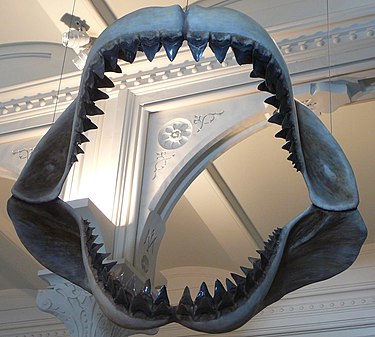-
- Megalodon, meaning “big tooth”, is an extinct species of shark that lived approximately 23 to 3.6 million years ago, during the Early Miocene to the Pliocene.
- It’s one of the largest predators to have ever lived. Estimates suggest it could grow up to 60 feet (18 meters) long, though some argue it could have been even bigger.
- The Megalodon’s teeth were built for grabbing prey and breaking bone. They were thick and robust, built like daggers, and could grow over 7 inches long.
- Despite its size, the Megalodon was likely a fast swimmer. It was a powerful predator that could tackle even large prehistoric whales.
- Megalodon likely had a strong bite. Some scientists estimate its bite force to have been around 10.8 to 18.2 tons, which is the strongest bite force of any creature ever.
- Like modern sharks, Megalodon continually grew new teeth throughout its life. Some Megalodons may have produced tens of thousands of teeth.
- Fossil evidence of Megalodon primarily consists of teeth and vertebrae, as the rest of the shark’s skeleton was composed of cartilage, which doesn’t fossilize well.
- Megalodon had a global distribution and fossils have been found all over the world, from tropical to temperate seas.
- It’s unclear why Megalodon went extinct, but it likely involved a combination of climate change, shifting food sources, and competition with other predators.
- Megalodon isn’t the direct ancestor of the great white shark, but they’re distant cousins. They both belong to the shark family Lamnidae.
- Megalodon would have been at the very top of the food chain, and likely had a significant impact on the structuring of marine communities.
- The Megalodon’s large size could be attributed to live birthing and cannibalism in utero, a phenomenon where larger embryos eat smaller embryos.
- Scientists believe that juvenile Megalodons likely preferred shallow, coastal waters, where they would have access to ample food and protection from larger predators.
- Due to their large size and power, Megalodons likely didn’t face threats from any species other than their own.
- The earliest known fossils of Megalodon are about 20 million years old.
- Megalodon’s closest living relative is the Carcharodon carcharias, or the great white shark.
- Megalodon’s diet consisted of a variety of marine animals, including giant whales, small whales, dolphins, sea turtles, and large fishes.
- Megalodon’s swimming speed is estimated to have been 11 to 13 mph, but bursts of speed could have reached 31 mph.
- There’s a popular but incorrect belief that Megalodon still exists today in the deep ocean. There’s no scientific evidence to support this claim.
- The Megalodon has entered popular culture as a great and monstrous beast, being featured in movies, books, and video games.
Facebook Comments


































